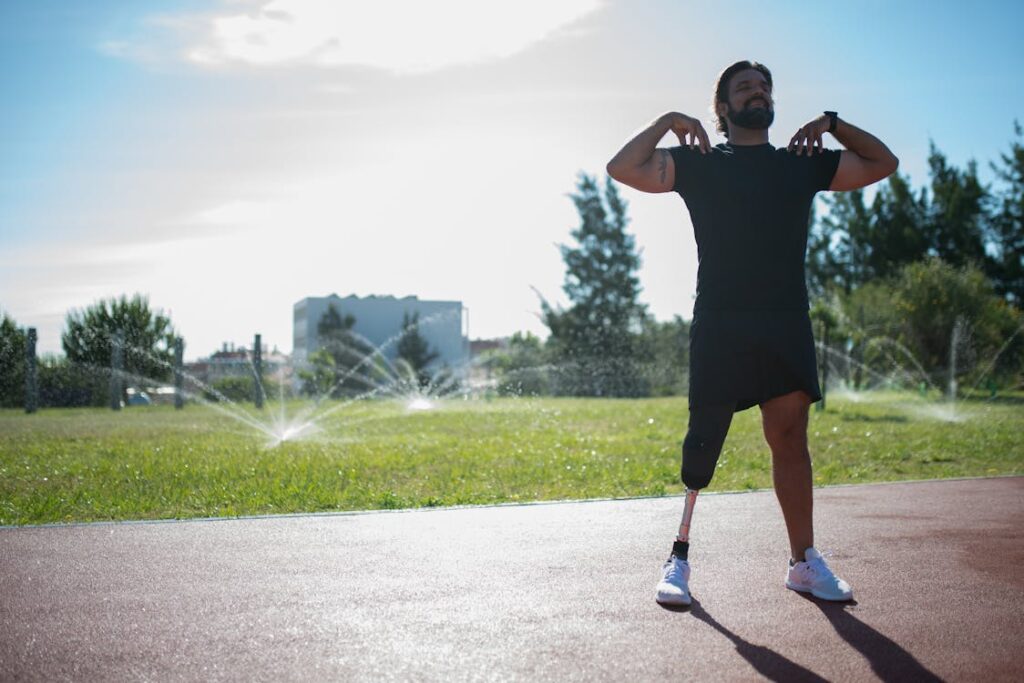Exercise is one of the most powerful tools for amputees to regain strength, improve balance, and stay active. After limb loss, the body must adapt to new ways of moving, which can sometimes lead to muscle imbalances, stiffness, or reduced mobility. Regular movement helps strengthen the muscles that support the residual limb, improve posture, and make using a prosthetic limb easier.
For many amputees, the idea of starting an exercise routine can feel overwhelming, especially if mobility is limited. The good news is that there are exercises tailored to different levels of ability, whether someone is newly adjusting to a prosthetic limb or has been active for years. The right approach focuses on building core strength, improving flexibility, and maintaining overall endurance to ensure the body remains strong and balanced.
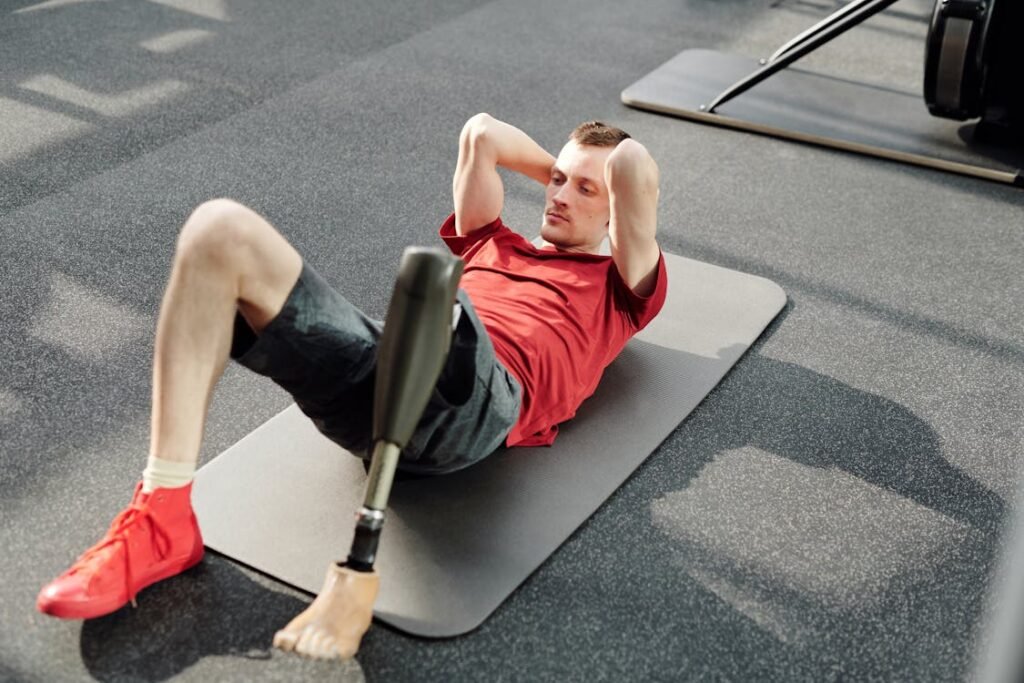
Building Core Strength for Better Balance and Stability
A strong core is the foundation of movement for everyone, but for amputees, it plays an even bigger role in maintaining balance and stability. The core includes the abdominal muscles, lower back, and hip muscles, all of which help support the spine and pelvis.
After limb loss, the body naturally shifts its weight to compensate for the missing limb, which can lead to muscle imbalances and poor posture. Strengthening the core helps prevent these issues, making movements more controlled and reducing the risk of falls.
Engaging the core is essential for everything from standing up to walking with a prosthetic limb. Simple exercises that target these muscles can make daily activities easier and more comfortable.
Seated exercises are a great starting point, especially for those who are still adjusting to movement after amputation. Sitting upright and engaging the abdominal muscles while lifting the arms or rotating the torso can activate the core without straining other parts of the body.
For those who are able to lie down comfortably, exercises such as pelvic tilts and leg raises can further strengthen the core. Breathing plays a key role in core engagement, so focusing on deep, controlled breaths while performing exercises can improve muscle activation.
Over time, as core strength improves, standing exercises such as controlled knee lifts or side bends can help further enhance balance and stability.
Strengthening the Upper Body for Better Support
The upper body takes on more work after an amputation, especially for those using crutches or wheelchairs. Strengthening the shoulders, arms, and back is crucial for maintaining endurance and preventing strain.
A strong upper body also helps with transfers, such as moving from a seated position to standing, which can make daily life easier and more independent.
Exercises that focus on resistance training can build strength without requiring heavy equipment. Using light weights, resistance bands, or even household items like water bottles can provide enough resistance to challenge the muscles.
Arm curls, shoulder presses, and seated rows help build upper body strength while also improving posture. These exercises can be performed while sitting or standing, depending on individual comfort and mobility.
In addition to strength training, flexibility is equally important. Stretching the shoulders, neck, and upper back helps relieve tension and improves range of motion.
Many amputees experience tightness in these areas due to compensatory movements, so incorporating regular stretching can reduce discomfort and improve overall mobility.
Improving Leg Strength for Stability and Mobility
For lower-limb amputees, maintaining strength in the remaining leg is essential for stability and movement. The intact leg takes on more responsibility, so keeping it strong helps with walking, standing, and using a prosthetic limb.
Exercises that focus on the quadriceps, hamstrings, and glutes can provide better support and reduce strain on the joints.
Seated leg extensions and standing leg lifts help strengthen these muscles without putting too much pressure on the joints. As strength improves, exercises like step-ups or partial squats can further enhance stability.
Controlled movements with a focus on form ensure that the muscles are engaged properly, preventing unnecessary stress on the joints.
Balance exercises are also an important part of lower-body strength training. Standing on one leg while holding onto a stable surface can help improve balance and coordination.
For those using a prosthetic, practicing weight shifting from one leg to the other helps the body adjust to different positions, making walking smoother and more natural.
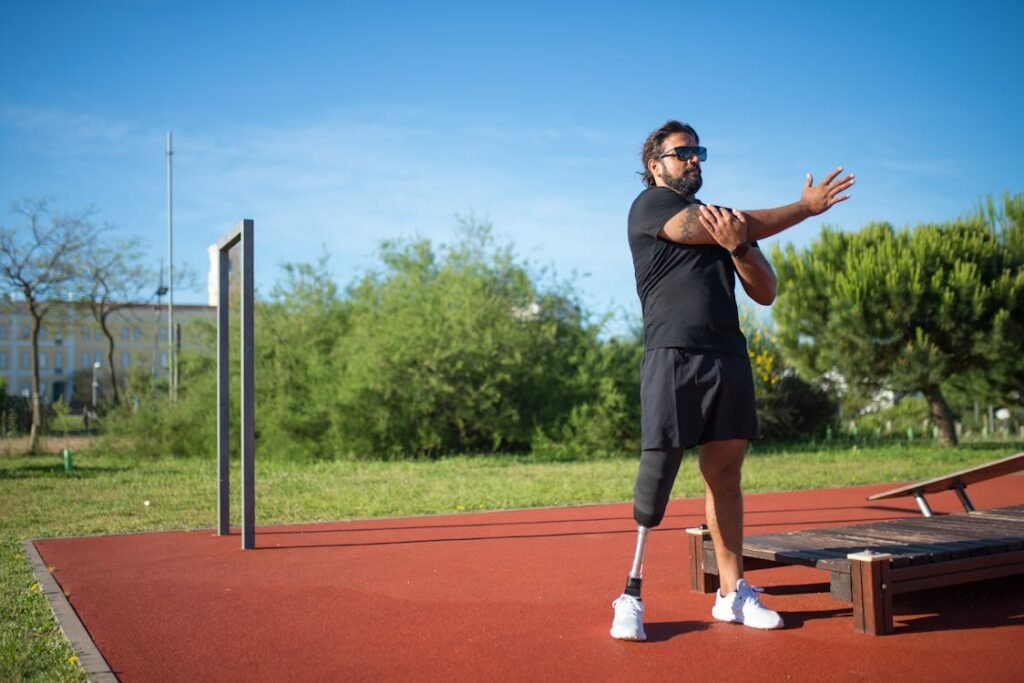
Enhancing Flexibility and Range of Motion
Flexibility is a key part of movement, especially for amputees who rely on different muscle groups to support their mobility. Without proper stretching, muscles can become tight, leading to stiffness, discomfort, and even reduced range of motion.
Regular flexibility exercises help keep the body limber, improve circulation, and reduce the risk of injury.
One of the most common issues amputees face is tightness in the hips and lower back. When the body compensates for a missing limb, the muscles surrounding the pelvis often become overworked, leading to stiffness.
Stretching exercises that target the hip flexors, hamstrings, and lower back can help relieve this tension. Sitting upright and gently reaching for the toes, tilting the pelvis forward and back, or performing controlled hip rotations can improve flexibility in these key areas.
For upper-limb amputees, shoulder and chest stretches help maintain a full range of motion. Over time, reduced use of the affected side can lead to stiffness, which can make daily tasks more difficult.
Simple movements like reaching overhead, rolling the shoulders back and forth, or using a resistance band to stretch across the chest can keep the upper body flexible and reduce discomfort.
Controlled breathing during stretching enhances relaxation and helps deepen the stretch. Holding each position for a few seconds while focusing on slow, deep breaths allows the muscles to fully release tension.
Stretching after any strengthening exercise or physical activity ensures that the muscles stay loose and adaptable, making movement smoother and more comfortable.
Balance and Coordination Training for Stability
Maintaining balance is a major concern for many amputees, especially those using a prosthetic limb. Good balance allows for smoother movement, reduces the risk of falls, and makes walking more natural.
Since the body’s center of gravity shifts after limb loss, retraining balance is essential for overall mobility.
One of the simplest ways to improve balance is through weight-shifting exercises. Standing with feet shoulder-width apart and slowly shifting weight from one side to the other helps the body adjust to movement changes.
For prosthetic users, practicing gradual weight transfer onto the artificial limb improves confidence and stability while walking. Holding onto a sturdy surface, such as a chair or parallel bars, provides additional support when starting out.
Core strength plays a big role in balance, so engaging the abdominal muscles while standing can improve stability.
Slightly bending the knees, keeping the back straight, and tightening the core while maintaining balance helps reinforce good posture and prevents unnecessary strain on the joints.
For those who feel comfortable progressing further, standing on one leg for short periods improves coordination and body awareness.
Prosthetic users can start by balancing on their intact limb while gradually placing more weight on the prosthetic. Over time, this exercise strengthens the stabilizing muscles and makes movements more controlled.
Incorporating slow, controlled walking exercises also enhances coordination. Focusing on foot placement, step length, and arm movement while walking improves overall body mechanics.
Whether using a prosthetic or other mobility aids, practicing these movements daily builds confidence and makes everyday activities easier.
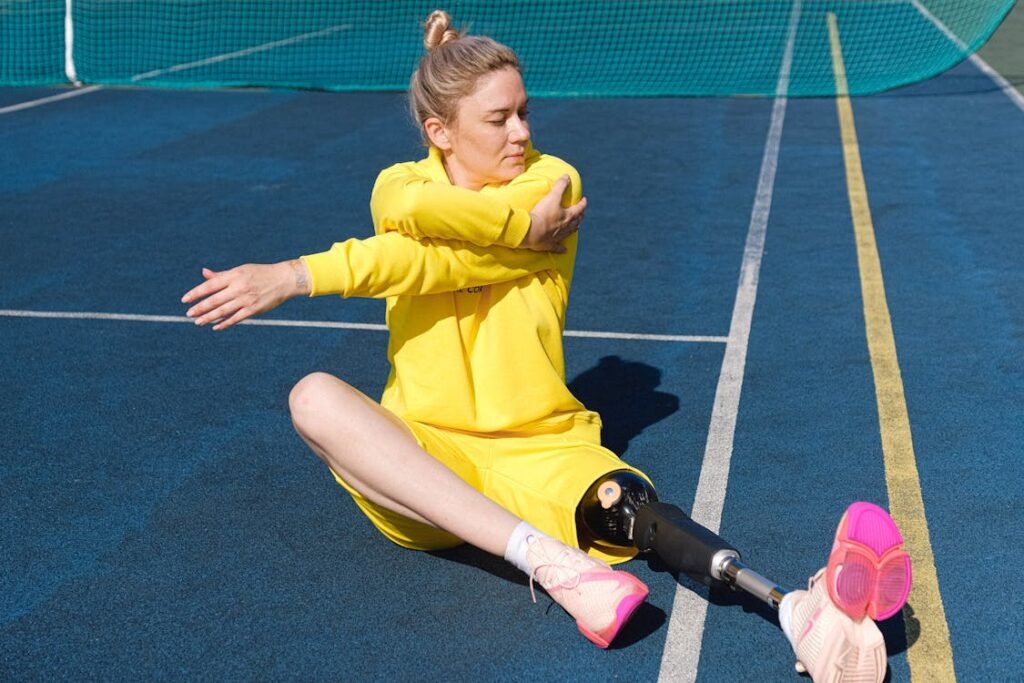
Cardiovascular Exercises to Improve Endurance and Circulation
Cardiovascular exercise is essential for heart health, circulation, and overall stamina. Many amputees worry about how to engage in cardio workouts safely, especially if they experience balance issues or discomfort while moving.
The good news is that cardiovascular fitness can be improved with a variety of low-impact exercises that are adaptable to different mobility levels. Regular cardio activity helps boost endurance, making daily activities easier and reducing fatigue.
Low-Impact Cardio for Amputees
For those who are new to exercise or adjusting to movement after amputation, low-impact activities provide an effective way to get the heart rate up without putting excess strain on the joints.
One of the best forms of cardiovascular exercise for amputees is swimming. The buoyancy of water reduces the impact on the limbs while providing resistance to strengthen muscles. Swimming also improves lung capacity, making it easier to stay active for longer periods.
Cycling is another excellent option for cardiovascular fitness. Stationary bikes offer a controlled and safe way to exercise without the risk of falling.
Depending on mobility, amputees can use modified pedals, straps, or specialized adaptive cycling equipment to ensure comfort and stability.
Cycling strengthens the leg muscles and enhances coordination, making it a great way to build endurance without excessive pressure on the body.
For upper-limb amputees, seated cardio exercises can provide an effective workout. Arm ergometers, which function like a bicycle for the arms, help improve cardiovascular endurance while building upper body strength.
Rowing machines also provide a full-body workout, engaging both the arms and legs to boost circulation and enhance overall fitness.
Walking and Prosthetic Training for Improved Stamina
Walking is one of the most functional cardiovascular exercises, as it directly improves mobility and independence. For lower-limb amputees, walking with a prosthetic limb requires endurance, coordination, and muscle control.
Starting with short, controlled walks and gradually increasing duration allows the body to adjust safely. A focus on even weight distribution and proper posture can make walking smoother and more efficient.
Prosthetic users often find that walking on different surfaces challenges balance and strength in new ways. Practicing on smooth indoor floors before progressing to outdoor paths, grass, or inclines helps improve stability.
Over time, as endurance builds, longer walks become easier, making everyday activities like running errands or climbing stairs more manageable.
For those who are not yet comfortable walking for long distances, using parallel bars or a treadmill with handrails provides extra support while improving cardiovascular fitness.
Setting small goals, such as increasing the number of steps taken each day, can help track progress and maintain motivation.
The Importance of Cardiovascular Health for Amputees
Good cardiovascular health benefits more than just endurance. It helps with circulation, reducing swelling in the residual limb and improving oxygen delivery to the muscles.
Proper blood flow supports tissue healing, which is especially important after surgery or when adjusting to a prosthetic. Regular cardiovascular exercise also helps regulate blood sugar levels, reducing the risk of conditions like diabetes that can impact mobility.
In addition to physical benefits, cardiovascular exercise plays a role in mental well-being. Engaging in regular movement releases endorphins, which help improve mood, reduce stress, and increase energy levels.
Many amputees experience emotional challenges during their recovery, and staying active can provide a natural way to relieve anxiety and boost confidence.
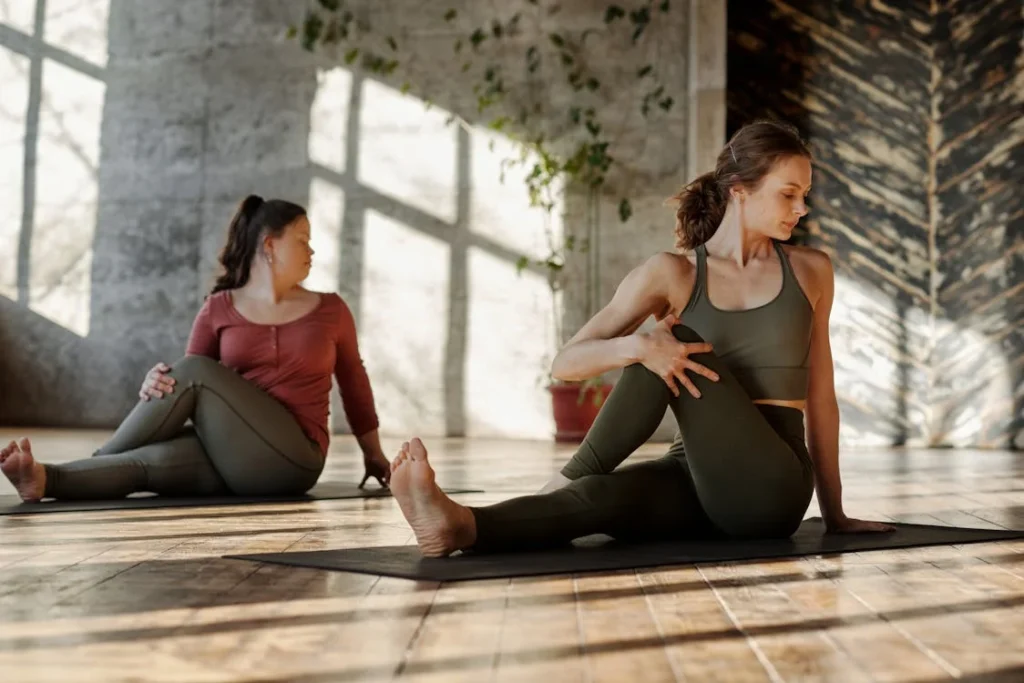
Strengthening the Mind-Muscle Connection for Better Mobility
Exercise is not just about physical movement—it also involves training the brain to work in sync with the body. After limb loss, the nervous system must adapt to new movement patterns, and the brain must learn how to control balance, posture, and coordination in a different way.
Developing a strong mind-muscle connection can help amputees move with greater control, reduce the risk of injury, and improve overall mobility.
Retraining the Brain to Adapt to New Movement Patterns
When a limb is lost, the brain still retains the memory of how that limb functioned. This is why many amputees experience phantom limb sensations, as the brain continues to send signals to the missing limb.
Over time, the brain must rewire itself to recognize the new movement patterns required for balance and coordination. This process, known as neuroplasticity, allows the nervous system to create new connections that support better movement.
One way to strengthen the mind-muscle connection is through visualization techniques. Many athletes use visualization to improve their performance by imagining each movement before physically performing it.
Amputees can use the same technique by mentally rehearsing movements, such as walking, standing, or using a prosthetic limb. By picturing each step in detail, including weight shifts and muscle engagement, the brain strengthens the pathways that control movement.
Controlled, Intentional Movements for Stability
Moving slowly and with purpose helps reinforce good movement habits. Rushed or uncontrolled movements can lead to imbalances, increasing the risk of strain or falls.
Practicing slow, intentional motions allows the brain to register how the body is positioned and which muscles need to be engaged.
For example, when standing up from a seated position, focusing on pressing through the feet, engaging the core, and maintaining proper posture helps train the brain and body to work together.
Exercises that require balance and coordination, such as weight shifting or single-leg standing, also help build the mind-muscle connection. These exercises force the brain to focus on stabilizing the body while adjusting to different weight distributions.
Over time, this improves proprioception, which is the body’s ability to sense its position in space. Better proprioception leads to smoother, more controlled movements when walking or using a prosthetic limb.
The Role of Feedback in Improving Movement
Using sensory feedback is another way to strengthen the connection between the brain and muscles. When performing exercises, paying attention to how the body feels—such as pressure in the foot, tension in the core, or balance in the hips—helps refine movement patterns.
Mirrors can be useful for visual feedback, allowing amputees to see their posture and adjust their form as needed.
For prosthetic users, focusing on how the prosthesis interacts with the ground can also improve control.
Noticing how weight is distributed across the foot, how the knee responds to bending, or how the socket fits during movement provides valuable feedback that can be used to make adjustments. Over time, this awareness leads to greater confidence and ease in daily activities.
Strengthening the Mind-Muscle Connection for Long-Term Success
Developing a strong connection between the brain and muscles takes time and practice, but it has lasting benefits for mobility and independence.
By focusing on visualization, controlled movements, and sensory feedback, amputees can improve their ability to move with confidence and precision.
This approach not only enhances physical strength but also boosts mental resilience, making it easier to navigate the challenges that come with limb loss.

Adapting Exercises to Different Types of Amputations
Every amputation is unique, and the best exercises depend on the type of limb loss, level of mobility, and personal comfort.
While core strength, balance, and flexibility are essential for all amputees, certain movements may need to be modified based on whether the amputation is above the knee, below the knee, above the elbow, or below the elbow.
Understanding how to adapt exercises ensures safety, maximizes effectiveness, and helps build confidence in movement.
Exercises for Lower-Limb Amputees
For those with a below-the-knee amputation, maintaining strength in the thigh muscles is crucial for stability. The quadriceps, hamstrings, and glutes work together to support standing, walking, and prosthetic use.
Seated leg lifts, partial squats, and resistance band exercises can help strengthen these muscles without placing too much strain on the residual limb. Engaging the core during all movements helps distribute weight evenly, improving balance and reducing stress on the joints.
Above-the-knee amputees often face additional challenges with balance and weight distribution, as they rely on their hip muscles for stability. Strengthening the hip flexors and gluteal muscles is key for maintaining mobility and controlling movement.
Seated core exercises, hip bridges, and controlled weight shifting can help improve coordination and make walking with a prosthetic limb smoother.
Practicing standing movements with parallel bars or a sturdy surface provides extra support while building strength and confidence.
For lower-limb amputees who do not use a prosthetic, seated and floor exercises provide a great way to stay active. Upper body strength becomes even more important, especially for those who rely on crutches or wheelchairs.
Resistance band exercises, rowing motions, and controlled arm movements help build endurance and prevent muscle imbalances. Stretching exercises also help maintain flexibility, reducing stiffness and improving overall comfort.
Exercises for Upper-Limb Amputees
For those with an upper-limb amputation, maintaining strength in the shoulders, back, and core is essential for balance and mobility. Many daily activities require using one arm more than the other, which can lead to muscle imbalances over time.
Strengthening both sides of the body helps improve posture and prevents overuse injuries. Seated resistance exercises, shoulder rotations, and core stabilization movements can help maintain upper body strength and coordination.
Below-the-elbow amputees can perform most traditional upper-body exercises, with minor modifications to accommodate grip and stability. Using resistance bands or weight straps can provide better control while strengthening the arms and shoulders.
Engaging the core during all exercises helps prevent excessive strain on the remaining limb and ensures that movements remain controlled.
Above-the-elbow amputees may rely more on their core and legs for support, making lower-body strength just as important as upper-body endurance. Balance exercises, seated core workouts, and controlled arm movements help develop better overall stability.
Using adaptive equipment, such as weighted cuffs or resistance machines, can help engage the upper body without requiring a strong grip.
Adjusting Movements for Comfort and Safety
Regardless of the type of amputation, the most important aspect of exercise is comfort and safety. Movements should always feel controlled and stable, with gradual progression to prevent strain.
If an exercise causes pain or discomfort, modifying the position or reducing intensity can help prevent injury. Listening to the body and making small adjustments ensures that exercise remains a positive and beneficial experience.
Working with a physical therapist or rehabilitation specialist can provide additional guidance on adapting exercises based on individual needs. Personalized exercise plans help maximize mobility, build strength, and ensure that movements are safe and effective.
Over time, as endurance improves and confidence grows, exercise becomes a powerful tool for maintaining independence and enhancing overall well-being.
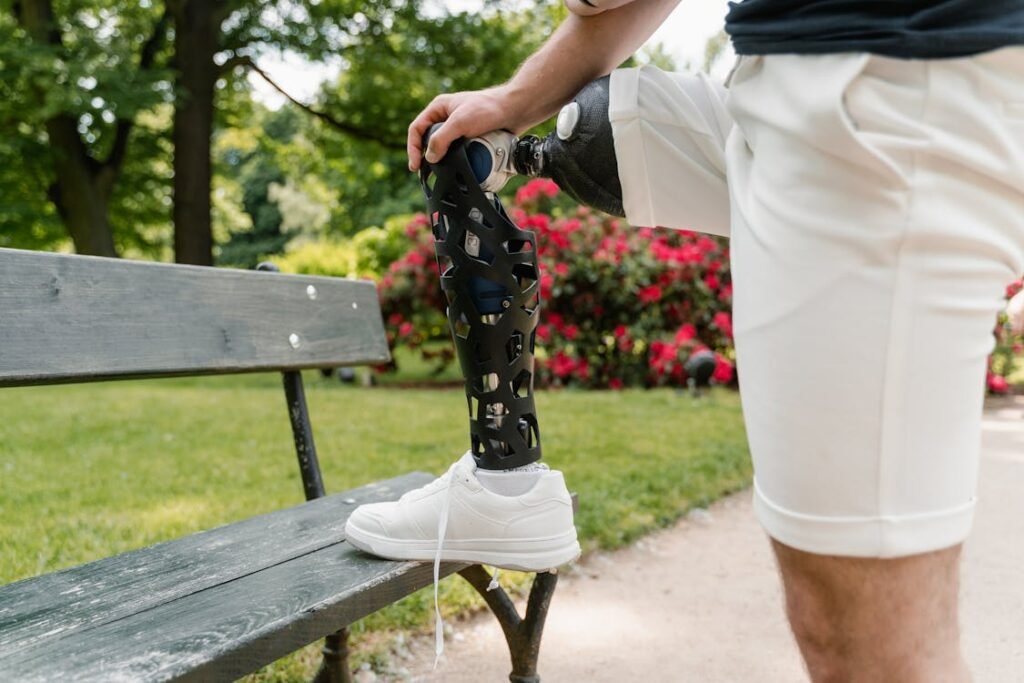
Overcoming Common Challenges in Exercise for Amputees
Starting and maintaining an exercise routine after limb loss can come with unique challenges. Many amputees experience discomfort, fear of injury, or frustration when learning new movements.
Others may struggle with motivation, especially during the adjustment period when mobility feels different. Understanding these challenges and finding ways to overcome them makes it easier to stay active, build strength, and improve overall well-being.
Managing Discomfort and Residual Limb Sensitivity
One of the biggest concerns for amputees when exercising is discomfort in the residual limb. This can be caused by swelling, skin irritation, or pressure from a prosthetic limb.
Finding the right balance between movement and rest is essential to prevent overuse injuries while still building strength.
If discomfort occurs while wearing a prosthetic, adjusting the fit or using a soft liner can provide relief. For exercises that put pressure on the residual limb, such as seated leg lifts or weight-bearing movements, using a padded surface can help reduce irritation.
Gradually increasing activity levels instead of pushing too hard too soon allows the body to adapt without excessive strain.
Stretching before and after workouts helps loosen tight muscles, improving circulation and reducing stiffness. Gentle massage or heat therapy can also provide relief for sore muscles, making it easier to stay consistent with exercise.
If pain persists, working with a prosthetist or physical therapist can help identify necessary adjustments for comfort.
Overcoming Balance and Stability Issues
Balance is a major challenge for many lower-limb amputees, especially when learning to use a prosthetic limb. The body’s center of gravity shifts, requiring extra focus on core engagement and weight distribution.
Initially, standing exercises may feel unstable, but with practice, balance improves over time.
Starting with seated or supported exercises helps build strength before progressing to more advanced movements. Holding onto parallel bars, a sturdy chair, or using a walker can provide additional stability when practicing standing exercises.
Engaging the core muscles and maintaining a slow, controlled pace prevents unnecessary strain while improving coordination.
For those with an upper-limb amputation, balance challenges can also arise due to changes in weight distribution. Core exercises and postural training help prevent compensatory movements that can lead to back pain or muscle imbalances.
Using both sides of the body evenly, rather than relying too much on the intact limb, improves overall stability.
Staying Motivated and Overcoming Mental Barriers
Exercise is not just a physical challenge—it also requires mental strength. Many amputees experience frustration when they are unable to perform movements the way they did before limb loss.
Comparing current abilities to past experiences can make progress feel slow, leading to a loss of motivation.
Setting small, achievable goals helps build confidence and provides a sense of accomplishment. Instead of focusing on major milestones, tracking improvements in balance, endurance, or comfort during movement can highlight progress.
Celebrating small victories, such as walking longer distances, lifting slightly heavier weights, or feeling less discomfort, reinforces motivation.
Having a strong support system can make a huge difference. Exercising with a friend, joining a rehabilitation group, or working with a trainer who understands limb loss can provide encouragement and accountability.
Surrounding yourself with people who celebrate progress, rather than focusing on limitations, makes staying active feel rewarding rather than frustrating.
Adjusting Expectations and Finding Enjoyable Activities
Not every workout will feel easy, and that’s okay. Some days will be more challenging than others, and it’s important to listen to the body’s signals.
If fatigue or soreness makes movement difficult, taking a rest day or switching to a lighter activity, such as stretching or swimming, can keep the body engaged without pushing too hard.
Finding exercises that feel enjoyable rather than like a chore increases consistency. Some amputees enjoy adaptive sports like cycling or swimming, while others prefer strength training or yoga.
Exploring different forms of movement and adapting exercises to personal preferences helps make exercise a sustainable part of daily life.
Overcoming challenges in exercise takes time and patience, but the benefits—better mobility, increased strength, and improved mental well-being—are well worth the effort.
With the right mindset and approach, staying active becomes a powerful way to regain confidence, independence, and a greater quality of life.
Conclusion
Exercise is a powerful tool for amputees, helping to build strength, improve balance, and enhance mobility. While limb loss presents unique challenges, regular movement allows the body to adapt, making daily activities easier and more comfortable. Whether focusing on core stability, flexibility, cardiovascular health, or strength training, each step forward contributes to greater independence and confidence.
Progress takes time, and every small improvement matters. Adjusting to new movement patterns, overcoming balance issues, and managing discomfort are all part of the journey. The key is to stay consistent, listen to your body, and find exercises that feel enjoyable and sustainable. Seeking guidance from physical therapists, trainers, or support groups can provide valuable motivation and expertise.
At Robobionics, we are committed to helping amputees regain mobility and confidence with innovative prosthetic solutions and personalized support. If you’re looking for expert advice on improving movement and comfort, contact us today to explore how our advanced prosthetics and rehabilitation programs can help you stay active and independent.



